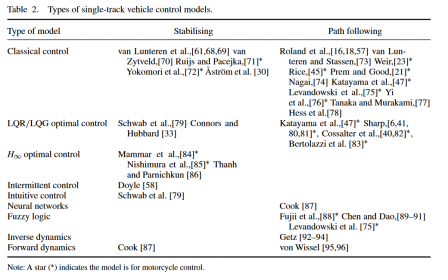Some notes about the following paper :
- J.D.G. Kooijman & A.L. Schwab (2013) A review on bicycle and motorcycle rider control with a perspective on handling qualities, Vehicle System Dynamics, 51:11, 1722-1764 - DOI: 10.1080/00423114.2013.824990 - (free version here)
Chapter 2 provides an extensive bibliography about the dynamics of single-track vehicles and concludes by :
Recently and based on the work by Meijaard et al.,2 Kooijman et al. 28 showed boththeoretically and experimentally that the long-cited myths, essential for bicycle self-stability:trail and gyroscopic effect of the front wheel, are neither required nor necessary for bicycleself-stability. They also showed that a third set of parameters, the mass and mass moments ofinertia, can be used just as effectively for stabilising and destabilising a bicycle. This discoveryradically changes the available design space for self-stable bicycles. For example, in the samework, they present a design for a self-stable rear-wheel-steered bicycle.
Chapter 3 introduces rider modelling. Is rider's motion considered negligible? What type of steer control does he perform ? It claims that ...
For automobiles, it has generally been accepted that the driver performs position (angle) control.36,37
but highlights the differences :
The automobile driver performs large rotational motions of the steering wheel during normal driving situations. This is not the case on bicycles and motorcycles, where the handlebar is only turned through a very small angle.
then makes the difference between ...
stabilising control and path following control
with further explanation :
Stabilising control is generally implemented when the goal is to understand the machine to be controlled, i.e. the effort required to keep the machine from falling over. Path following control is implemented when the goal is to follow a set course. There are generally two path following approaches: the first is compensatory, where the current position is compared with the pre-determined desired position and the control output adjusted accordingly to compensate for a miss-match. The second path following control approach uses look ahead (preview).
Then follows a review of qualitative analysis (mostly for bicycles) of rider control, then of quantitative analysis (for motorcycles).
Some authors (Aoki and Katayama) show that steering torque is the dominant control.
The level of experience of the rider seems to be important (according to Rice for example) :
they found significant differences amongst the rider groups with regard to leaningaction. The novice riders appear to use only upper body lean as a reactive rather than deliberate control, unlike more experienced riders.With the second experiment: entering a constant radius turn,45 Rice found that novice riders only use steer torque control to initiate the turn while experienced riders use their upper body to get the motorcycle in the desired lean before they apply a steer torque in the desired direction. It was recently shown with multi-body software by Balleti et al. 65 that this type of control, where the rider uses upper body lean to roll the bike in the desired direction and then applies a steer torque, allows a quicker and more precise manoeuvre at a given speed.
In §3.2, it is said that the rider’s influence on the system can be split into two aspects: a controller; and added system dynamics
.
Three roads can be followed for the controller part : classical control, optimal control, and "alternative" strategies (fuzzy logic, neural network ...).

(to be continued)

